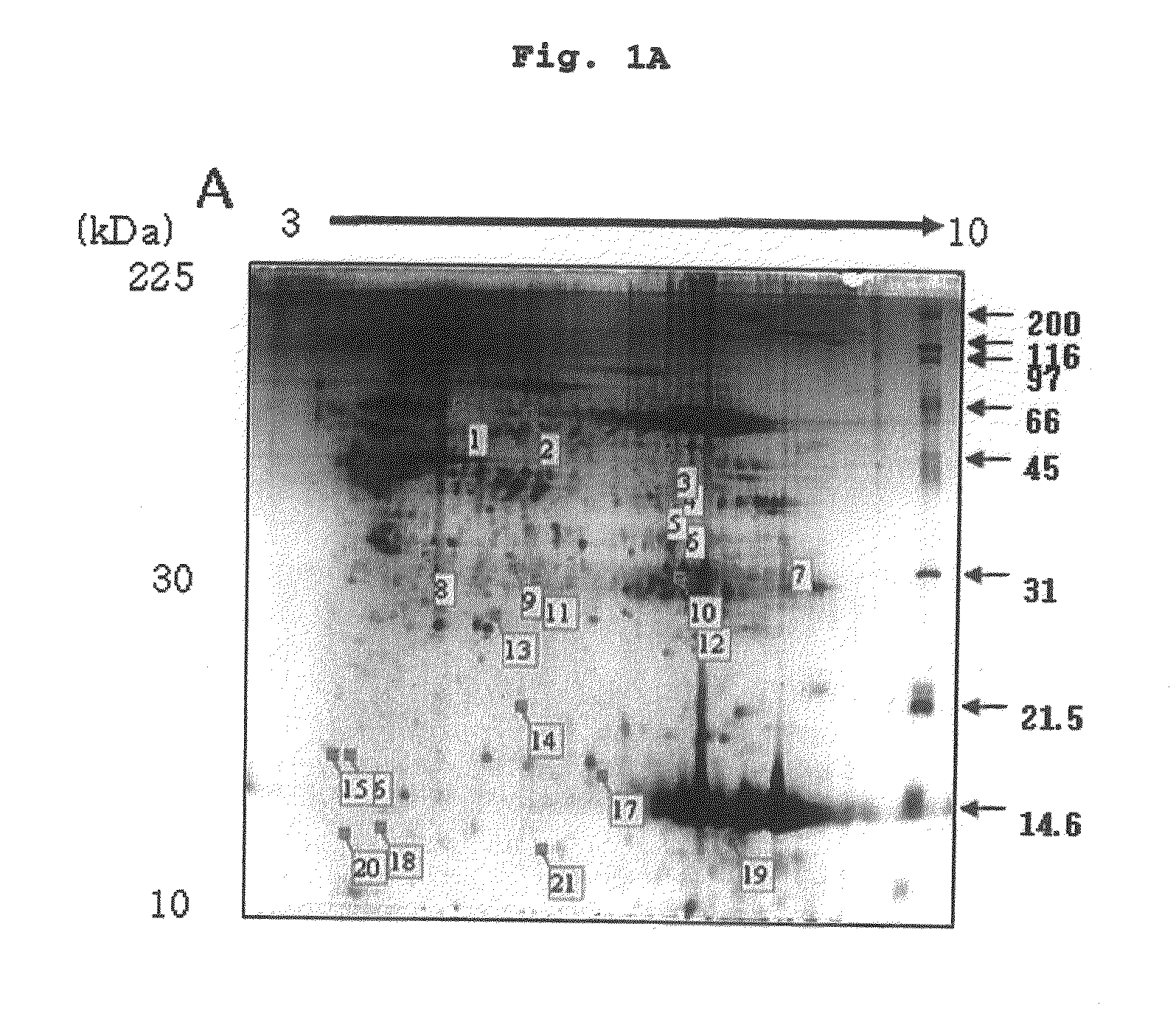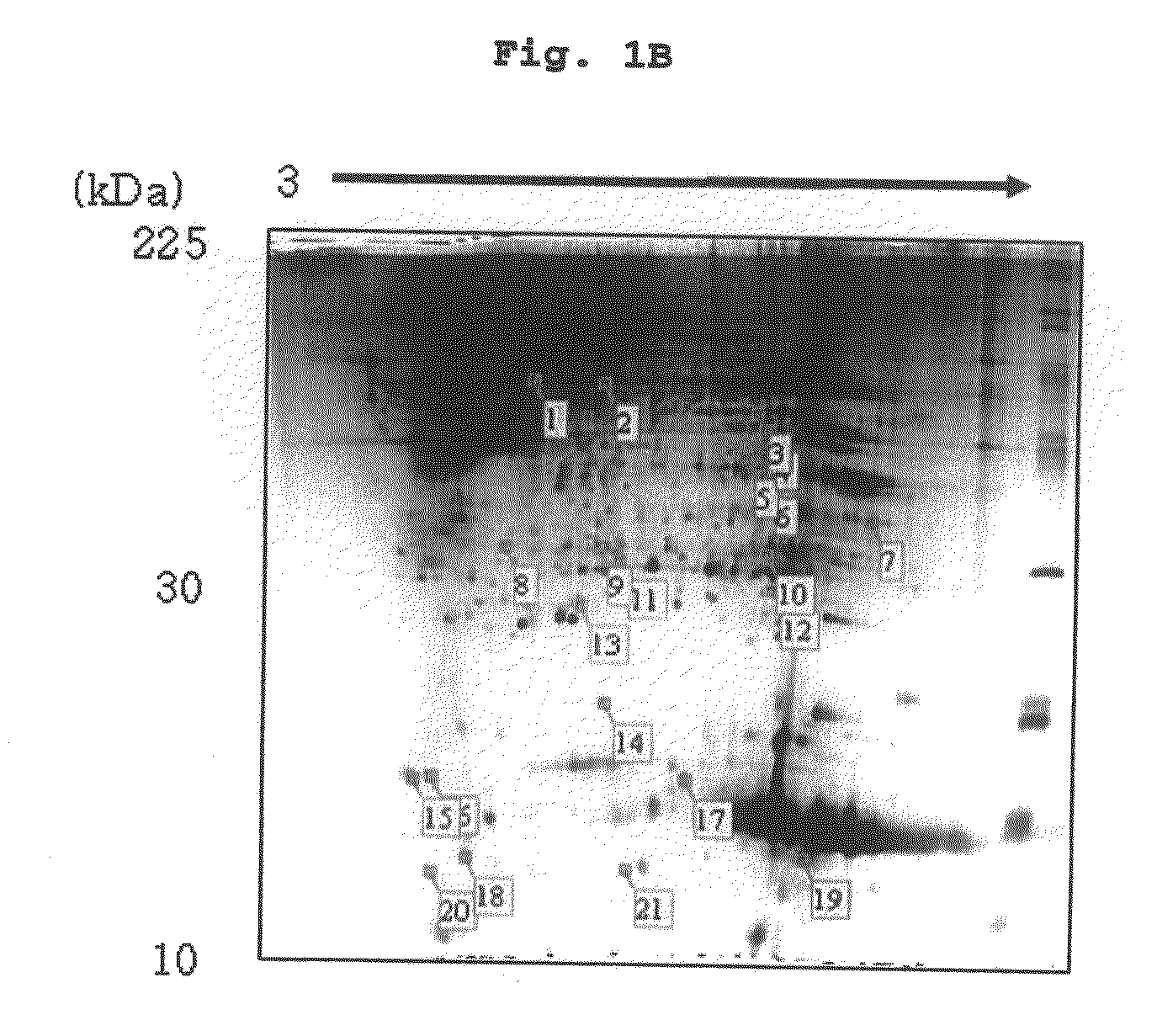Method of screening placental proteins responsible for pathophysiology of preeclampsia, and marker for early diagnosis and prediction of preeclampsia
a technology of placental proteins and pathophysiology, which is applied in the field of screening placental proteins responsible for the pathophysiology of preeclampsia, and a marker for early diagnosis and prediction of preeclampsia, can solve the problems of preeclampsia in pregnancy that can be a very serious health problem, fetal growth restriction, premature delivery,
- Summary
- Abstract
- Description
- Claims
- Application Information
AI Technical Summary
Benefits of technology
Problems solved by technology
Method used
Image
Examples
example 1
Separation of Placental Proteins
[0022]Normal placenta and preeclamptic placenta were prepared for 2D E-proteomics analysis. Placental tissues were ground to fine powder in presence of liquid nitrogen, and a buffer (tissue: 0.2 g / 10 ml) was added thereto. The samples were then divided into tubes, boiled for five minutes, put into the ice bath for five minutes, and centrifuged at 8,000 rpm and 4° C. for 10 minutes. Each of the upper phases was transferred to a new tube by 800 μl, treated with enzymes (DNase / RNase), and put into the ice bath for 10 minutes. Next, 200 μl of 10% TCA / acetone preparation-50% TCA / acetone was added to each tube. The tubes were placed into the ice bath for a period of 1 hour. The samples were then centrifuged at 12,000 rpm and 4° C. for 10 minutes, and the resulting pallets were washed with acetone. The remaining dry powders were kept at −20° C.
example 2
Separation of Proteins by 2D E-Proteomics
[0023] Primary Separation of Proteins by Isoelectric Point
[0024]Proteins are primarily separated based on isoelectric point. Dry immobilized pH gradient (IPG) strips of 13 cm were added with 250 μl isoelectric point marker containing 50 μg protein and rehydrated over 10 hours. The rehydrated IPG strips were subjected to isoelectric point separation in an IPG phore (GE Healthcare, USA). The isoelectric point separation was carried out for 1 hour at 500 V, for 1 hour at 1,000 V, and finally at 8,000 V until the final accumulated voltage becomes 60,000 V. At this time, the highest current was set to 50 μA per strip. The strips separated by isoelectric point were slowly stirred over a period of 15 minutes in presence of a primary phase equilibrium solution (50 mM Tris-HCl containing 6M urea, 30% glycerol, 2% SDS, bromophenol blue and 1% DTT, pH 8.8). These primary phase equilibrated strips were soaked in a secondary phase equilibrium solution (50...
example 3
Gel Scanning and Gel Image Analysis
[0027]The stained gel was scanned through a flatbed scanner (UMAX PowerLook 1100, USA). During scanning, the option of a transmissive type with 300 dpi resolution was chosen. The scanned gel images were analyzed through an image analysis program (Image Master 2D Platinum, GE Healthcare, USA). Based on the image analysis result, proteins showing differences up to 140% or more in two groups of placental samples were selected and finally identified. In result, the inventors checked proteins showing big differences between normal placenta and preeclamptic placenta by electrophoresis shown in FIG. 1 (In FIG. 2, left-hand side: normal cell; right-hand side: gastric cancer cell), and identified 21 proteins with differences in expression between normal placenta and preeclamptic placenta.
PUM
| Property | Measurement | Unit |
|---|---|---|
| pH | aaaaa | aaaaa |
| size | aaaaa | aaaaa |
| pH | aaaaa | aaaaa |
Abstract
Description
Claims
Application Information
 Login to View More
Login to View More - R&D
- Intellectual Property
- Life Sciences
- Materials
- Tech Scout
- Unparalleled Data Quality
- Higher Quality Content
- 60% Fewer Hallucinations
Browse by: Latest US Patents, China's latest patents, Technical Efficacy Thesaurus, Application Domain, Technology Topic, Popular Technical Reports.
© 2025 PatSnap. All rights reserved.Legal|Privacy policy|Modern Slavery Act Transparency Statement|Sitemap|About US| Contact US: help@patsnap.com



